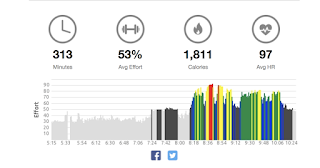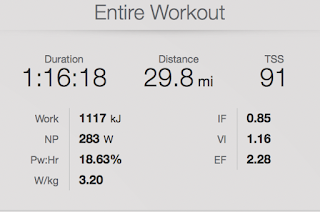Looking Out At The Road Rushing Under My Wheels
Saturday, March 31, 2018
Wednesday, March 28, 2018
Monday, March 26, 2018
20 minute time trial effort
Saturday, March 24, 2018
Thursday, March 22, 2018
Tuesday, March 20, 2018
Cycling Keeps Us Younger: NYT
How Exercise Can Keep Aging Muscles and Immune Systems ‘Young’
3 min at temp, 1 at SS, 1 at endurance X3 then 10 at SS.....repeat twice
268-336-243....297-331-231...308-343-208
Saturday, March 17, 2018
1-2-3-4-5 and 5-4-3-2-1 minutes at time trial power, 30 seconds between each, 10 minutes between sets
Friday, March 16, 2018
Finished Endure by Alex Hutchinson
I finished the book Endure by Alex Hutchinson yesterday. All in all a good read although it didn't really give much in the way of definitive actions to take or proven results of the balance of the body-mind interaction in our performance in endurance sports. There was certainly plenty of anecdotal evidence of the the mind being a major governor of our ability to perform to our true maximum potential. Also some very interesting studies of how we can fool our mind into allowing us to reach and surprise all expectations. How we bottle that is another question. The book does open ones eyes to the questions of how do we use our training to get our minds and bodies to go to the point of relegating pain to the side while we only concentrate on our best performance. Its definitely worth a read.
Thanks Magnet Digital!!
Very happy to say that Magnet Digital, the company that set up and maintains my website here and at Wimberg landscaping, is sponsoring my racing this year. It was quite a surprise when they contacted me with this offer. They have been great business partners over the years. They're very responsive to our questions and really know how to set up and manage our sites. I especially want to thank Kim Sharp for all of his time in working with me. He's a great part of a great company.
Indoor Century then off day
Did the indoor 100 yesterday, just a little under 5 hours. Started with 10 before breakfast, then did 30 mind-morning, 30 while watching the noon NCAA games and then 30 while watching the afternoon games. All in all, on the of the easier efforts as it was divided up. Average power was 214.
Off day today with some intense intervals tomorrow.
Wednesday, March 14, 2018
Monday, March 12, 2018
Sunday, March 11, 2018
More on Endure by Alex Hutchinson
I'm about 2/3 of the way through this book. So far, I haven't found a lot of 'you should do this in your training' moments as the author is shown the various sides of he argument of the mental vs physical training needed to be great. How critical is one to the other and how do you train them both for the best outcome?
As I read more today on the plane back from NYC I was somewhat pleased to read a lot fo evidence of what I could so far consider. very adequate training strategies over the years both from my coaches and back to the people I train. And both approaches have influenced the other. Some basic tenets that I think the book is confirming:
You have to sue your training to provide the physical requirements needed to meet your goals: seems obvious but you could read parts of the book and assume a strong will is all it takes and we know that isn't enough.
Your training should be training your mind in such a way that your building the will that is required to meet your goals. In other words, you can train hard but if you show up to an event and fall apart mentally, its all for naught. your training needs to replicate the physical and mental requirements of the event. thats a lot harder than it seems and I think this is where a lot of people fall apart. Taking the mental aspect to that level can be very difficult. I like to think that riding 30-35 time trails per year gets my mind in line with the demands needed at the key events. And it certainly gets me physically there.
Its very easy to turn of the mental and not get the physical results. I see this in my weekly Cleves time trials. Years ago, it meant everything to me. Now, its just training. My training says I should be just as fast, or close, to my PR's. I truly just don't care any more. That being said, I've ridden PR's on other courses. because I care and have the physical ability still.
Its good to combine mental training with the physical in my opinion. At this point in the book its debatable but performing mental gymnastics while riding (inside!) is good training for both the brain and body. I read a lot inside, even while cranking out time trial level efforts, rather than just lessen to music. I also do work games (unscramble letters, form as many words as possible from groups of letters, etc). I never did this knowing it may help. It simply helped pass the time. But, I think it has allowed me to develop focus away from the pain of the training. We wont have music when racing but it is possible to use your mind to focus on cadence, breathing, power, etc...and not pain.
More to follow....great book!
Saturday, March 10, 2018
Friday, March 9, 2018
Thursday, March 8, 2018
Tuesday, March 6, 2018
Todays Ride
Monday, March 5, 2018
Endure by Alex Hutchinson
https://www.amazon.com/Endure-Curiously-Elastic-Limits-Performance/dp/0062499866
I'm only about halfway through this book. It is interesting but so far it's not really telling me anything I hadn't read before or talked about with others or even thought on my own. I don't want that last comment taken as some sort of credit for great ideas. I do think that after 38 years of riding, 312,000 miles, 700 races and a lot of reading and discussion that a lot of topics have been hashed out.
One initial thought would be that all training should be replicating the expected physical and mental challenges of your event. Thats right, physical and mental. By the time you toe the line at the big race you should be ready in mind and body. Too many people are lacking both.
That leads me to say this: too many people just don;lt train hard enough, even though they think they do. One of the firsts things my current coach (6+ years together now) asked me was whether I train to failure or race to failure. I said not on the latter but I have on the former. If we don't push ourselves to our upper limits, and that should really hurt, then we can never know what we're capable of. I'm opposed to failing in a race. My training should take to the limits or beyond so that on race day I know how far I can go. And, maybe I can go a step further, as they're is always more.
When we train we need to push the limits. When I see the results of my field test (and I try to do better each time we test, even after almost 20 years) and my zones have changed, I continually try to train at the upper ends and then go beyond them. If we just always stay within the wattage range, maybe we'll happen to get stronger but we have to push into the upper ends and go beyond. I'm not saying I always do this but like in todays intervals the goal based on power tests was 326 for steady state and I held 333-350. That last effort shows I could probably do all fo them at 350, so what don't I? The one minute goal was 360 and I went for 390-420. I held that range on each. Why not 420 all the time? As I was doing these I thought about my one minute PR power at 612 watts. Could I throw that in and come back to a 5 minute at 330? I was about to say no but I'e never tried it. Maybe I could.
My times at Cleves the last few years are definitely off do to mental fatigue with that event. After 325 races on the course I really just don't care. I can ride at 85-90% and still put out a good time. Theres no reason that I shouldn't be riding with more power and going faster. My times are in the mid 22's. I should be able to get back in the 21's. My training power is at times better than what I put out in that event. When I've raced at state and national competitions my power is some of the best I've ever held. Even at 55 years old, I'm as strong or stronger than I was at 46-48 when I was posting better times at our Tuesday race. I just have a hard time caring about it. Its good training but thats it.
So, with plenty of book still to go I have no need to be convinced that our minds are critical to our success. Once we achieve a certain level of fitness, we need to be able to dig deeper to pull out more power. We have to train our mind to make our body look past the pain and just do it. When I see people quitting in their training, and really no where near their max HR or holding power well below previous efforts, its all in their mind. They have to believe. They have to push through it. We all have to take things a little deeper into the unknown. Training is the pace to do it.
Saturday, March 3, 2018
4x8 steady states and indoor century















































